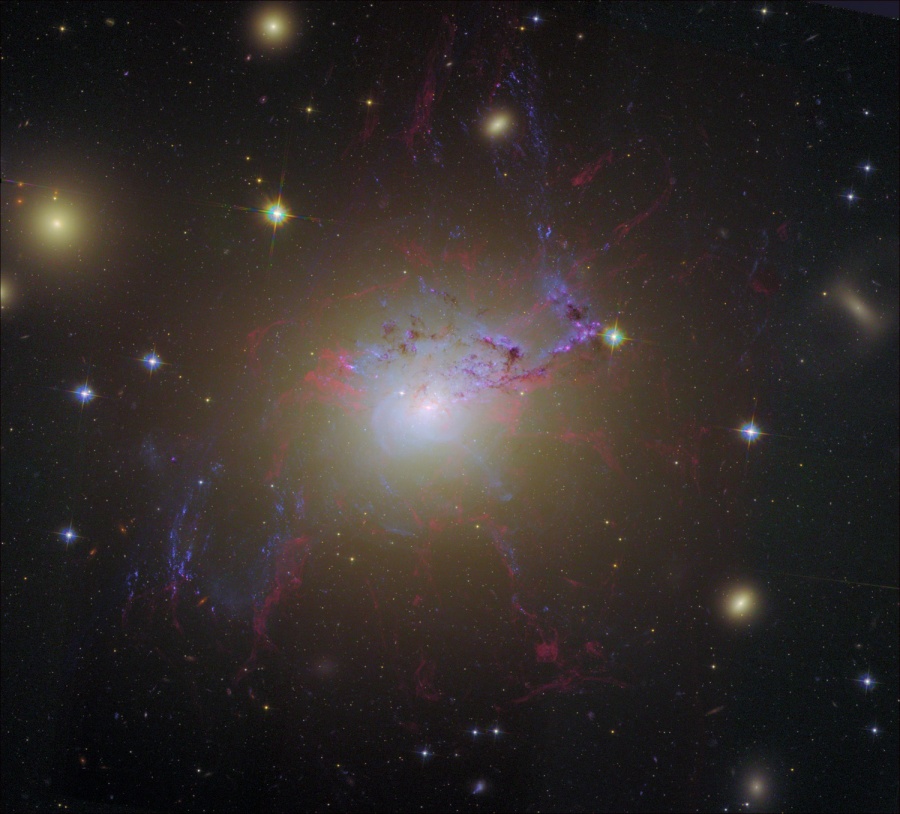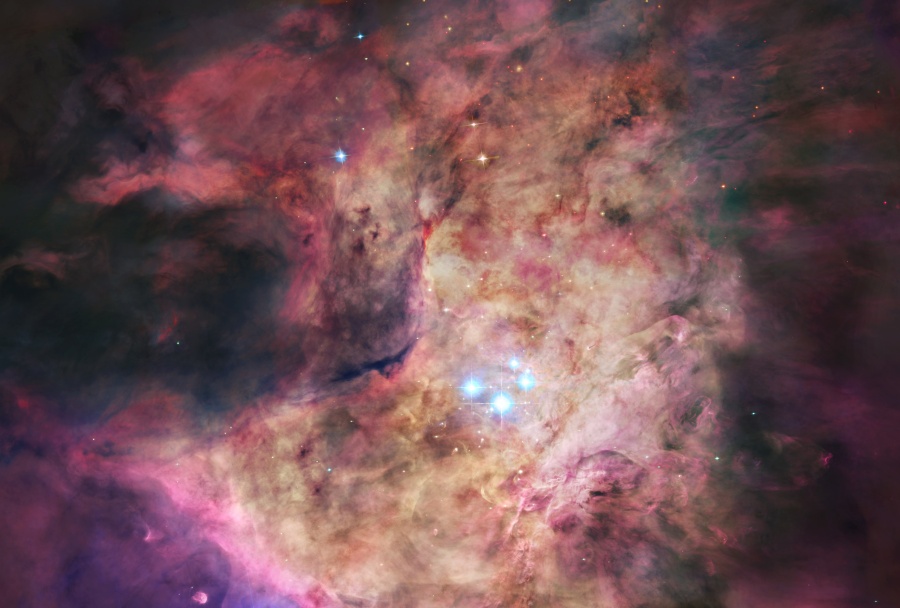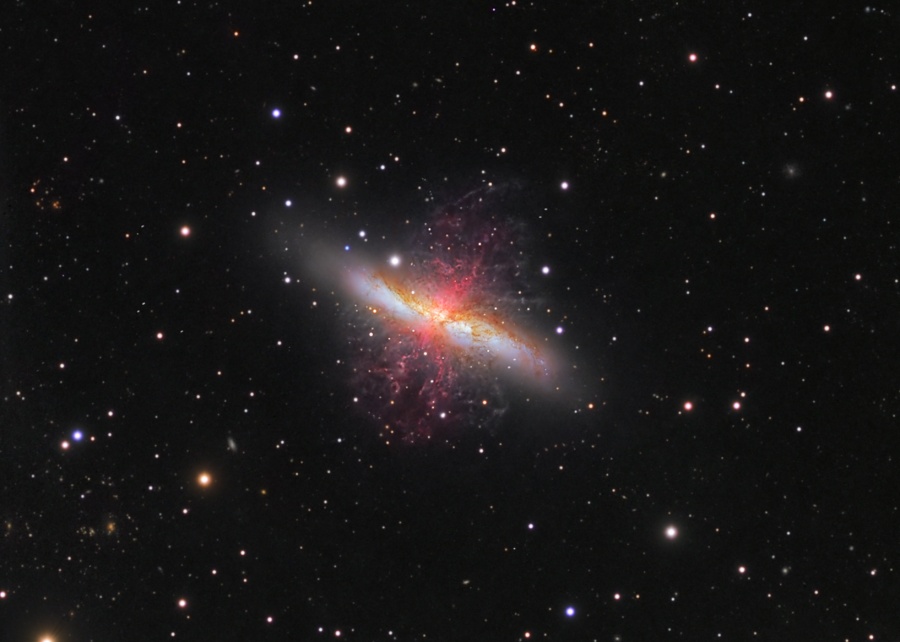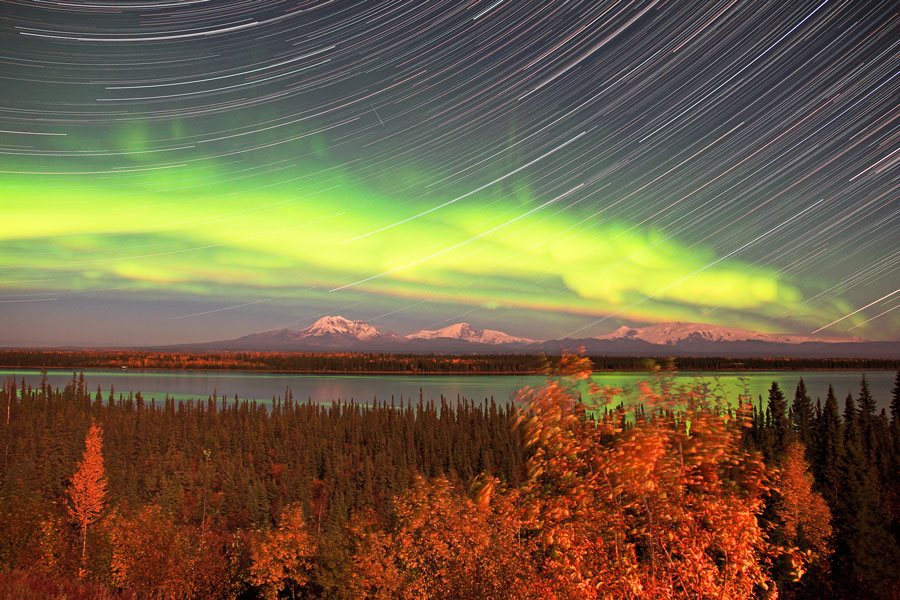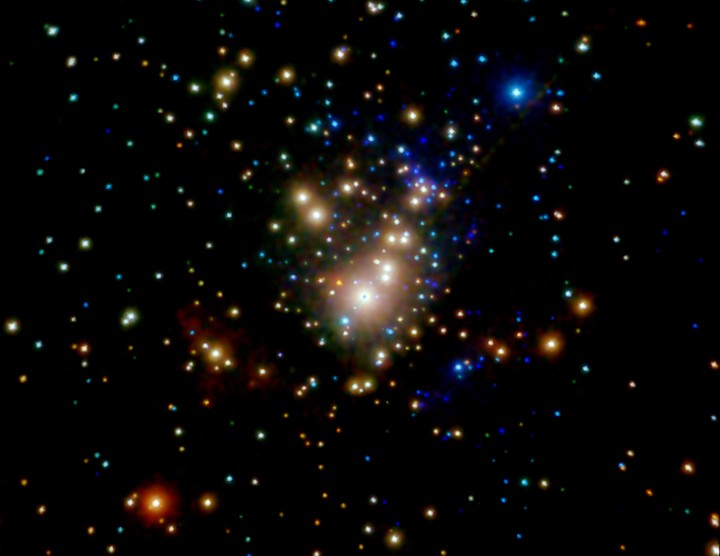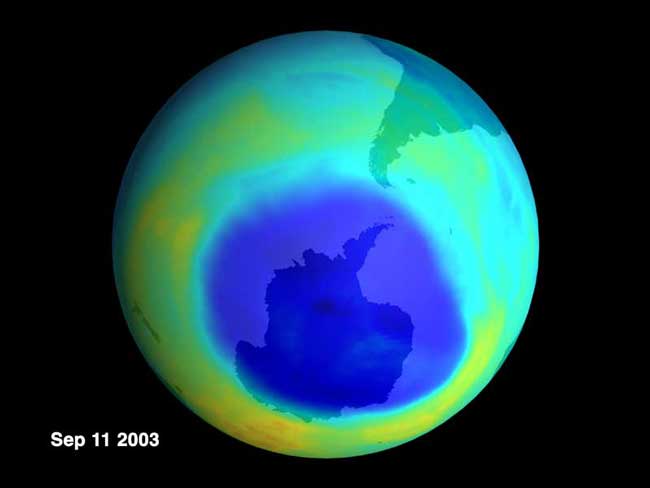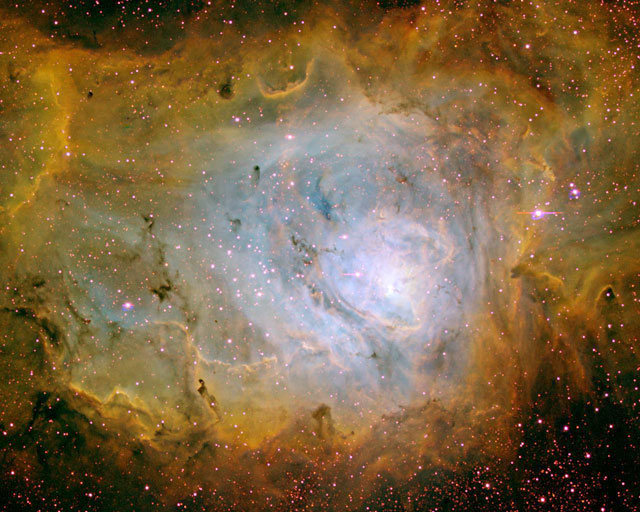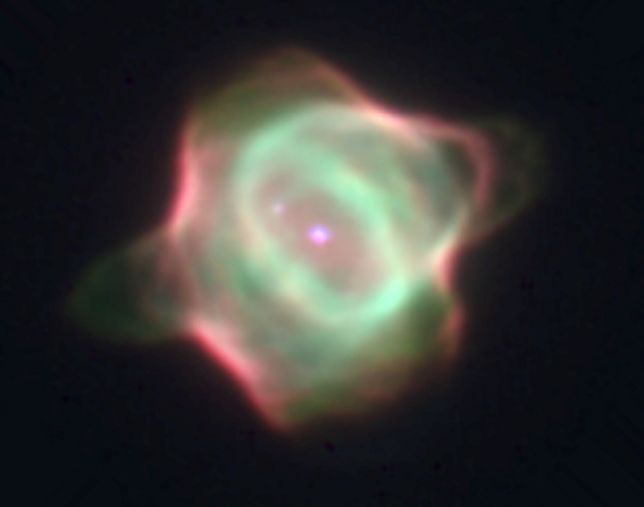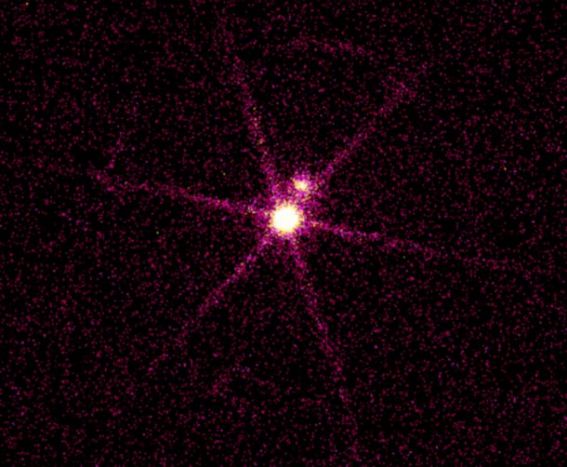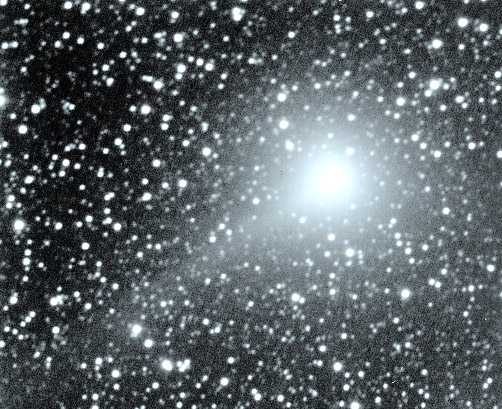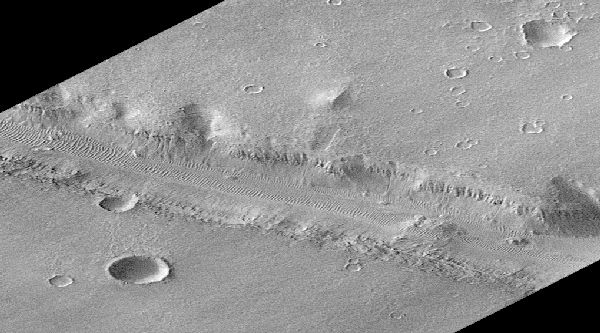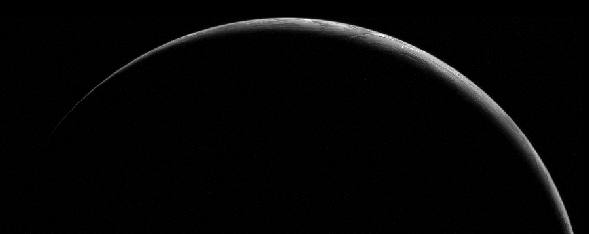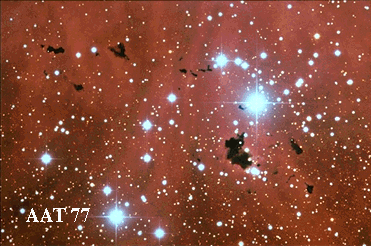| << Previous | Index | Next >> |
2014 Where did all these high energy positrons come from? The Alpha Magnetic Spectrometer (AMS-02) onboard the International Space Station (ISS) has been meticulously recording how often it is struck by both high energy electrons and positrons since 2011. After accumulating years of data, it has now become clear that there are significantly more positrons than expected at the highest energies detected. The excess may have a very exciting and profound origin -- the annihilation of distant but previously undetected dark matter particles. However, it is also possible that astronomical sources such as pulsars are creating the unexplained discrepancy. The topic remains a very active area of research. Pictured here, the AMS is visible on the ISS just after being installed, with a US Space Shuttle docked on the far right, a Russian Soyuz capsule docked on the far left, and the blue Earth that houses all nations visible across the background.
2013 Active galaxy NGC 1275 is the central, dominant member of the large and relatively nearby Perseus Cluster of Galaxies. Wild-looking at visible wavelengths, the active galaxy is also a prodigious source of x-rays and radio emission. NGC 1275 accretes matter as entire galaxies fall into it, ultimately feeding a supermassive black hole at the galaxy's core. This color composite image, recreated from archival Hubble Space Telescope data, highlights the resulting galactic debris and filaments of glowing gas, some up to 20,000 light-years long. The filaments persist in NGC 1275, even though the turmoil of galactic collisions should destroy them. What keeps the filaments together? Observations indicate that the structures, pushed out from the galaxy's center by the black hole's activity, are held together by magnetic fields. Also known as Perseus A, NGC 1275 spans over 100,000 light years and lies about 230 million light years away.
2012 Near the center of this sharp cosmic portrait, at the heart of the Orion Nebula, are four hot, massive stars known as the Trapezium. Gathered within a region about 1.5 light-years in radius, they dominate the core of the dense Orion Nebula Star Cluster. Ultraviolet ionizing radiation from the Trapezium stars, mostly from the brightest star Theta-1 Orionis C powers the complex star forming region's entire visible glow. About three million years old, the Orion Nebula Cluster was even more compact in its younger years and a recent dynamical study indicates that runaway stellar collisions at an earlier age may have formed a black hole with more than 100 times the mass of the Sun. The presence of a black hole within the cluster could explain the observed high velocities of the Trapezium stars. The Orion Nebula's distance of some 1500 light-years would make it the closest known black hole to planet Earth.
2011 Also known as the Cigar Galaxy for its elongated visual appearance, M82 is a starburst galaxy with a superwind. In fact, through ensuing supernova explosions and powerful winds from massive stars, the burst of star formation in M82 is driving the prodigous outflow of material. Evidence for the superwind from the galaxy's central regions is clear in this sharp composite image, based on data from small telescopes on planet Earth. The composite highlights emission from filaments of atomic hydrogen gas in reddish hues. The filaments extend for over 10,000 light-years. Some of the gas in the superwind, enriched in heavy elements forged in the massive stars, will eventually escape into intergalactic space. Triggered by a close encounter with nearby large galaxy M81, the furious burst of star formation in M82 should last about 100 million years or so. M82 is 12 million light-years distant, near the northern boundary of Ursa Major.
2010 Are those green clouds or aurora? Photographed above two weeks ago, puffy green aurora help the Moon illuminate the serene Willow Lake and the snowy Wrangell and Saint Elias Mountains in eastern Alaska, USA. Although auroras might first appear to be moonlit clouds, they only add light to the sky and do not block background stars from view. Called northern lights in the northern hemisphere, auroras are caused by collisions between charged particles from the magnetosphere and air molecules high in the Earth's atmosphere. If viewed from space, auroras can be seen to glow in X-ray and ultraviolet light as well. Predictable auroras likely occur a few days after a powerful magnetic event has been seen on the Sun.
2009 The large majestic Lagoon Nebula is home for many young stars and hot gas. Spanning 100 light years across while lying only about 5000 light years distant, the Lagoon Nebulae is so big and bright that it can be seen without a telescope toward the constellation of Sagittarius. Many bright stars are visible from NGC 6530, an open cluster that formed in the nebula only several million years ago. The greater nebula, also known as M8 and NGC 6523, is named "Lagoon" for the band of dust seen to the left of the open cluster's center. A bright knot of gas and dust in the nebula's center is known as the Hourglass Nebula. The above picture is a newly released, digitally stitched panorama of M8 taken as part of the GigaGalaxy Zoom project by the Wide Field Imager attached to the MPG/ESO 2.2-meter Telescope at the La Silla Observatory in Chile. The vista spans three times the diameter of the Moon, while the highest resolution image version occupies over 350 million pixels. Star formation continues in the Lagoon Nebula as witnessed by the many globules that exist there.
2008 How did these layers of red cliffs form on Mars? No one is sure. The northern ice cap on Mars is nearly divided into two by a huge division named Chasma Boreale. No similar formation occurs on Earth. Pictured above, several dusty layers leading into this deep chasm are visible. Cliff faces, mostly facing left but still partly visible from above, appear dramatically red. The light areas are likely water ice. The above image spans about one kilometer near the north of Mars, and the elevation drop from right to left is over a kilometer. One hypothesis relates the formation of Chasma Boreale to underlying volcanic activity.
2007 The stars of Orion shine brightly in visible light in planet Earth's night sky. The constellation harbors the closest large stellar nursery, the Great Nebula of Orion, a mere 1,500 light-years away. In fact, the apparently bright clump of stars near the center of this false color Chandra x-ray telescope picture are the massive stars of the Trapezium - the young star cluster which powers much of the nebula's visible-light glow. The stars shown in blue and orange are young sun-like stars; prodigious sources of x-rays thought to be produced in hot stellar coronae and surface flares in a young star's strong magnetic field. Our middle-aged Sun itself was probably thousands of times brighter in x-rays when, like the Trapezium stars, it was only a few million years old. The x-ray image spans about 2.5 light-years across the central region of the Orion Nebula.
2006
[imghover6=http://apod.nasa.gov/apod/image/0610/ng ... f70_01.jpg]http://apod.nasa.gov/apod/image/0610/ng ... 0_01-o.jpg[/imghover6]Credit: Visible Image (w/rollover) - Steve Cannistra (StarryWonders)
Infrared Image - R. A. Gutermuth (Harvard-Smithsonian CfA) et al. JPL-Caltech, NASA
Infrared Image - R. A. Gutermuth (Harvard-Smithsonian CfA) et al. JPL-Caltech, NASA
2005 This gorgeous island universe lies about 85 million light-years distant in the southern constellation Fornax. Inhabited by young blue star clusters, the spiral arms of NGC 1350 seem to join in a circle around the galaxy's large, bright nucleus - giving the galaxy the appearance of a limpid cosmic eye. NGC 1350 is about 130,000 light-years across making it as large or slightly larger than our own Milky Way. For earth-based astronomers, NGC 1350 is seen on the outskirts of the Fornax cluster of galaxies, but its estimated distance suggests that it is not itself a cluster member. The sharp image also reveals many background galaxies, some visible right through NGC 1350.
2004 How did this unusually large nebula form? One of the largest nebulas yet detected is actually a complex ring of emission nebulas connected by glowing filaments. The unusual network, known as N11, spans over 1000 light years and is a prominent structure of the Large Magellanic Cloud, the largest satellite galaxy of our Milky Way Galaxy. In the center of the above image is open star cluster LH9, also known as NGC 1760, composed of about 50 bright blue stars that emit radiation that has eroded a hole in their surroundings. A leading hypothesis for the formation of N11 is shells of successive generations of stars being formed further out from the center. The bright region just above center is N11B, an explosive domain where stars are being formed even today.
2003 As expected, the ozone hole near Earth's South Pole is back again this year. This year's hole, being slightly larger than North America, is larger than last year but short of the record set on 2000 September 10. Ozone is important because it shields us from damaging ultraviolet sunlight. Ozone is vulnerable, though, to CFCs and halons being released into the atmosphere. International efforts to reduce the use of these damaging chemicals appear to be having a positive effect on their atmospheric abundance. The relatively large size of the ozone hole this year, however, is attributed partly to colder than normal air in the surrounding stratosphere. The above picture of the ozone hole was taken on September 11 by TOMS on board the orbiting Earth Probe satellite.
2002 The bright Lagoon Nebula is home to a diverse array of astronomical objects. Particularly interesting sources include a bright open cluster of stars and several energetic star-forming regions. When viewed by eye, cluster light is dominated by an overall red glow that is caused by luminous hydrogen gas, while the dark filaments are caused by absorption by dense lanes of dust. The above picture, from the Curtis-Schmidt Telescope, however, shows the nebula's emission in three exact colors specifically emitted by hydrogen, oxygen, and sulfur. The Lagoon Nebula, also known as M8 and NGC 6523, lies about 5000 light-years away. The Lagoon Nebula can be located with binoculars in the constellation of Sagittarius spanning a region over three times the diameter of a full Moon.
2001 This Hubble Space Telescope snapshot shows Hen-1357, the youngest known planetary nebula. Graceful, gentle curves and symmetry suggest its popular name - The Stingray Nebula. Observations in the 1970s detected no nebular material, but this image from March 1996 clearly shows the Stingray's emerging bubbles and rings of shocked and ionized gas. The gas is energized by the hot central star as it nears the end of its life, evolving toward a final white dwarf phase. The image also shows a companion star (at about 10 o'clock) within the nebula. Astronomers suspect that such companions account for the complex shapes and rings of this and many other planetary nebulae. This cosmic infant is about 130 times the size of our own solar system and growing. It is 18,000 light-years distant, in the southern constellation Ara.
2000 In visible light Sirius A (Alpha Canis Majoris) is the brightest star in the night sky, a closely watched celestial beacon throughout recorded history. Part of a binary star system only 8 light-years away, it was known in modern times to have a small companion star, Sirius B. Sirius B is much dimmer and appears so close to the brilliant Sirius A that it was not actually sighted until 1862, during Alvan Clark's testing of a large, well made optical refracting telescope. For orbiting x-ray telescopes, the Sirius situation is exactly reversed, though. A smaller but hotter Sirius B appears as the overwhelmingly intense x-ray source in this Chandra Observatory x-ray image (lines radiating from Sirius B are image artifacts). The fainter source seen at the position of Sirius A may be largely due to ultraviolet light from the star leaking into the x-ray detector. With a surface temperature of 25,000 kelvins, the mass of the Sun, and a radius just less than Earth's, Sirius B is the closest known white dwarf star. Can you guess what makes Sirius B like Neptune, the Sun's most distant gas giant planet? While still unseen, the presence of both celestial bodies was detected based on their gravitational influence alone ... making them early examples of dark matter.
1999 Polaris is quite an unusual star. First, Polaris is the nearest bright star to the north spin axis of the Earth. Therefore, as the Earth turns, stars appear to rotate around Polaris, making it the North Star. Since no bright star is near the south spin axis of the Earth, there is currently no South Star. Thousands of years ago, Earth's spin axis pointed in a slightly different direction, and Vega was the North Star. Although Polaris is not the brightest star on the sky, it is easily located because it is nearly aligned with two stars in the cup of the Big Dipper, and is the last star in the handle of the Little Dipper. In the above picture, Polaris is the brightest star on the right, above the fleeting streak of a Perseid meteor. The surface of Polaris slowly pulsates, causing the star to change its brightness by a few percent over the course of a few days. This rare Cepheid variability of Polaris is, oddly enough, itself changing.
1998 The brightest comet in the sky right now is Comet Williams. Moving slowly though the constellation of Centaurus, Comet Williams, at magnitude 8, is visible to Southern Hemisphere observers with binoculars. In ten days, Comet Williams will reach its closest point to the Sun, although it will still be farther from the Sun than the Earth. Comet Williams should become visible to many Northern Hemisphere observers in late November. At magnitude 10, however, it might require a small telescope to see. Comet Williams was discovered in early August by Peter Williams. The above image was taken August 25th from Australia.
1997 Mars Global Surveyor achieved Martian orbit on September 11 and began aerobraking into its final mapping orbit, a process that will take until March next year. Anticipating the labors ahead, Mars Orbital Camera operators have begun acquiring test images. This dramatic detail of a recent image shows a 10 mile wide swath of a highland valley, part of the Nirgal Vallis system. The original image was recorded from an altitude of 250 miles at a resolution of about 30 feet per pixel and has been rotated to represent the camera's perspective view. Were these valleys formed by flowing water or did collapse and erosion caused by ground water produced the channel? What other processes were important? Time will tell. From its planned mapping orbit, with four times better resolution, Mars Global Surveyor's images should provide answers to these and other questions about Mars.
1996 The Earth's northern hemisphere appears outlined as a sunlit crescent in this dramatic view from the GOES 8 satellite. The image was made near midnight for the Geostationary Operational Environmental Satellite on June 22 this year, two days after the Summer Solstice. The Summer Solstice is the time of year when the sun reaches its greatest northern declination and the arctic regions near the top of the picture experience 24 hours of daylight. Looking south along the Earth's limb, atmospheric scattering of sunlight causes the bright crescent to be visible beyond areas directly illuminated by the sun.
1995
| << Previous | Index | Next >> |

